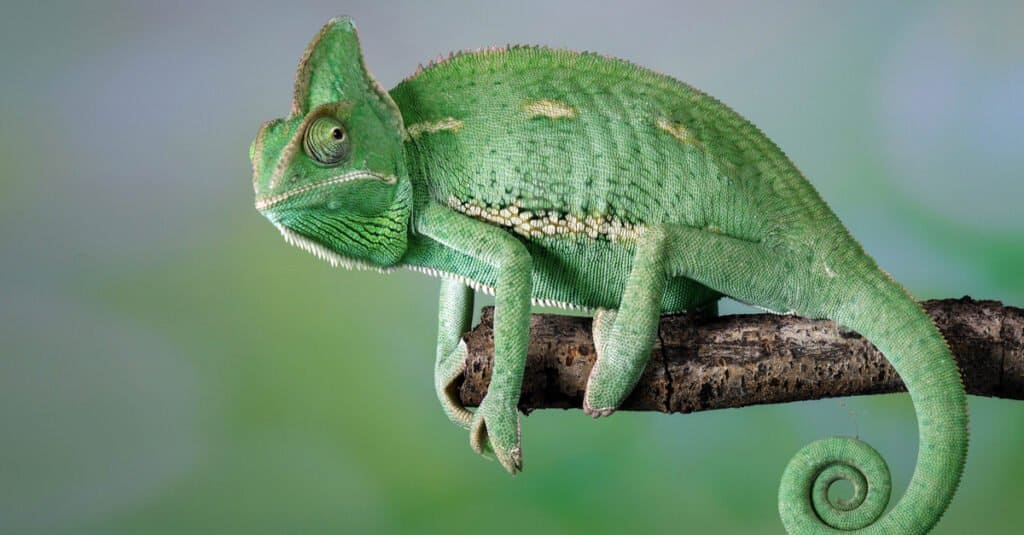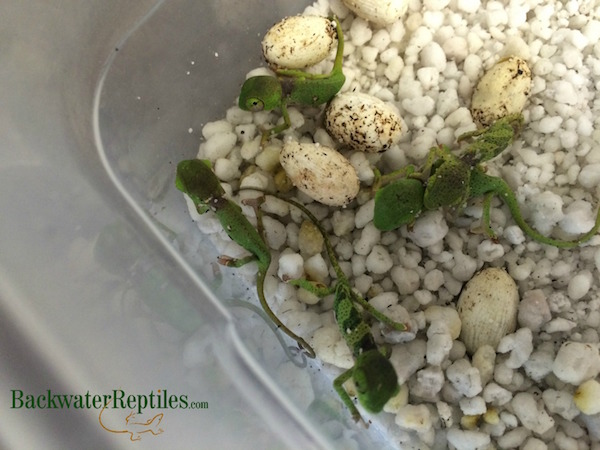
There aren’t many things cuter than a baby chameleon—just ask anyone who walks into my facility and interacts with one. They’re just so fragile, and their locomotion so comical and clumsy. They keyword though, is fragile. Baby chameleon care is a whole new ballgame. They have special requirements that must be met, and i can tell you from having raised thousands of them—they aren’t very forgiving. But, they’re definitely worth the extra work. Below i’ll explain how baby chameleons are different than their older counterparts, including some pictures and information about hatching, live-births, and anecdotal observations. Here’s a mother and baby rudis chameleon i happened across.

By oddblog chameleons are popular reptiles known for their ability to change color based on their surroundings. There are many subspecies of chameleons, such as the panther chameleon and the bright green veiled chameleon. Even though these lizards are well-known, there are a lot of misconceptions about the amount of care they require. If you are considering a baby chameleon, there are a few things you need to know about their care requirements. Caring for baby chameleons is not recommended for beginner reptile keepers. They’re sensitive to handling and may die quickly. Even outside this, they often don’t survive long due to their intense environment and dietary requirements. https://kids.nationalgeographic.com/animals/reptiles/facts/chameleon
Waiting for chameleon eggs to hatch is a lesson in patience, but once they hatch there is a flurry of activity to care for the hatchlings. This page reviews what you need to know about feeding hatchling or newly born chameleons. For the purposes of this write-up, live birth chameleons are treated exactly the same. I will make it simple and refer to them as baby chameleons from now on. I will cover feeding topics from hatching or birth to about three months old. This information is appropriate for first time breeders with their first clutch of eggs, the first time owner that purchased an egg, and the owner of a live bearing species who just walked down the stairs and was surprised by 30 baby chameleons crawling around the cage.
Caring For Baby Chameleons: Tips You Must Know! [Read First]
Chameleons are some of the most iconic reptiles in the world. This family of lizards is famous for their beautiful colors and ability to change hue. Despite their popularity there is a lot of misinformation on how to care for a baby chameleon.
 Babies stress easily, are not domesticated and have specific diet and housing requirements. Caring for a baby chameleon is difficult and not recommended for beginners. If you are looking to adopt this species then read this article first to learn how to take care of them.
Babies stress easily, are not domesticated and have specific diet and housing requirements. Caring for a baby chameleon is difficult and not recommended for beginners. If you are looking to adopt this species then read this article first to learn how to take care of them.
Rhonda rivera last modified date: november 03, 2023 rhonda rivera last modified date: november 03, 2023 the best tips for caring for a baby chameleon are to purchase a small enclosure, house one baby chameleon per enclosure, and feed the animal crickets every day. A small enclosure lets you watch the animal for signs of health problems and stress and prevents it from harming itself by falling. Even baby chameleons can be aggressive and stressed out near other chameleons, so keep them separated whenever possible. In addition, baby chameleons need to be fed more often than adults, so keep live, well-fed insects on hand to satisfy them.
Veiled chameleons are diurnal, so they’ll be active the same as you during the day. They’ll also go to sleep around the same time as you or whenever you turn off their basking light. These quiet creatures will sleep for a good 12 hours every night, especially in the warmer months. However, they might sleep for about 13 or 14 hours a day during the colder months. Before you go to your local pet store and bring home a baby veiled chameleon, here are some final tips for caring for this reptile.
How much does a chameleon costs or a chameleon’s price is one of the curious questions we commonly get. How much is a chameleon for, depends widely on its species. I’ll mention the prices of the most widely demanded varieties of a chameleon to give you an idea. Baby panther chameleons’ price ranges between 150$ to 200$ due to their collation and how easy they are to care for. Baby veiled chameleons and baby jackson chameleons are other commonly preferred chameleons whose price ranges from 20$ to 80$. How much is a chameleon for, also depends on the type of breeder, locality, the reputation of a breeder and many such factors?.
Care of chameleons the following is a brief summary of general chameleon care, husbandry, and medicine. It is not all conclusive, but does provide a framework of necessary information for the chameleon owner. As with any pet, proper husbandry and veterinary care are the most important factors in a long, healthy life. It isn’t hard to see why so many people fall in love with chameleons, and desire to keep them as pets. They are interesting, colorful animals that are unlike so many other animals. However, any prospective chameleon owner should realize that they are fragile in nature, and have some very specific needs.
Baby chameleons are fragile and finicky. They’re difficult for beginners to care for. Chameleons are a “look but don’t touch” pet. You should only handle them when absolutely necessary. Baby chameleons that survive grow into adults that require large enclosures and expensive equipment. If you don’t know what you’re doing (and even if you do!), there’s a high chance your baby panther chameleon will die. Since panther chameleons are illegal to import from the wild, you can only buy captive-bred babies. They’re usually healthier but significantly pricier than wild-caught chameleons.